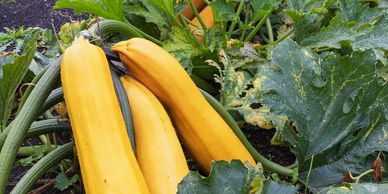Signed in as:
filler@godaddy.com
Signed in as:
filler@godaddy.com

Zucchinis are a delicious summer squash that is easy to grow if you have the room and are great in many different recipes. You can fry them, grill them, bake them, or steam them. They are great with eggs, added to casseroles, and superb when made into a relish. You can pick them when they are small and tender, which many people do. The seeds don’t get large when they are small, making them “meatier”, and they tend to be a darker green. You can also make zucchini flour out of them or you can grow them quite large for stuffing.
You should space your zucchini plants in rows, 18-24” apart in rows 6’ apart. The plants can get very large, and you are going to need room to harvest them. You also want good airflow to help cut down on their common diseases which include powdery mildew, downy mildew, bacterial mildew, and phytophthora, which can also infect pumpkins, other squashes, and melons, as well as peppers, tomatoes, beans, and eggplants. It is long-lived in your soil and is driven by moisture. I also make raised rows for them to avoid poor drainage and you must remember to rotate your crops.
When we start getting too many zucchinis, which happens most years, we let a few grow to about a foot and a half to two feet. Then Tami cuts them up the middle and makes a tasty stuffing with ground sausage, herbs, her homemade tomato gravy, breadcrumbs, and the meat from the zucchini. Then she bakes them in the oven with melted cheese on top.
Check out the picture and recipe on this page.

Summer squash is among the favorites of veggie gardeners. They are easy to grow and maintain, and they produce a large quantity of product if the plant is healthy. The old joke is “If you grow summer squash, friends and relatives stop answering the phone and the neighbors pull down the blinds and won’t answer the door”. Many folks who grow it are always looking for ways to use it before it goes bad. Our family has a lot of recipes for summer squash, but we can never seem to keep up with it, and we have nine people here and all but one person eats it! We’ve tried canning it over the years with not much luck. For us it always seemed to come out mushy. So we decided to try freezing it, and this is how we do it. It works!
Cut the squash in half, then cut it in spears, like pickles, but a bit thicker. Lay out wax paper on a cookie sheet and place the spears on the sheet, only doing one layer. Put the cookie sheet in your freezer for an hour to an hour and a half, then take out the cookie sheet, place the squash in vacuum seal bags and vacuum seal the squash. It freezes well this way, and you can take it out of the bags in the amount that you need per recipe.

Blueberries are a widely distributed berry plant classified in the Cyanococcus family along with huckleberries and cranberries. There are two kinds of blueberries: high bush and low bush. Both are native to North America. Low bush blueberries have small, pea-size berries and grow low to the ground. High bush blueberry bushes grow larger berries and can grow up to thirteen feet high. The U.S. produces approximately 40% of the world’s supply of blueberries while Canada is the leading producer of low bush blueberries.
We’ve been growing high bush blueberries here at our homestead for over twenty years and have been blessed to have a successful year every year. Mostly because blue berries are fairly easy to take care of. I check the soil for the proper ph every year and amend accordingly and we try to prune yearly.
Blueberries make excellent jam and are wonderful in many desserts. They are easy to freeze and dehydrate well.
We use cookies to analyze website traffic and optimize your website experience. By accepting our use of cookies, your data will be aggregated with all other user data.